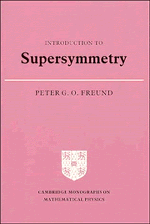27 - The present status of supersymmetry
Published online by Cambridge University Press: 01 June 2011
Summary
It may be appropriate to conclude this book by assessing the present status of the principle of supersymmetry in physics. A physical principle can be reliably evaluated according to the following criteria:
(A) The experimental evidence that supports the principle.
(B) New phenomena predicted on the basis of the principle.
(C) The experimental and theoretical puzzles solved by the principle.
(D) The internal consistency of theories that incorporate the principle.
(E) The aesthetic and philosophic advantages of the principle.
Let us now consider each of these five criteria and apply them to supersymmetry.
As the first three parts of this book imply, supersymmetry fares poorly on criterion (A). There is no hard evidence for supersymmetry in particle physics (at the time of this writing). Given the mathematical novelty of the concept, one may wonder whether supersymmetric systems appear in physics at all. There are two fields of physics in which supersymmetry does indeed make an appearance: the quantum statistical mechanics of two-dimensional systems and nuclear physics. We briefly review these examples with the main objective of showing that the set of supersymmetric physical systems is not empty.
First the example from the theory of two-dimensional systems. The tricritical Ising model, realized experimentally by adsorbing helium-4 on krypton plated graphite (notice the de rigueur appearance of krypton) near the critical point is supersymmetric. Near a critical point two-dimensional statistical systems scale and become conformally invariant.
- Type
- Chapter
- Information
- Introduction to Supersymmetry , pp. 137 - 141Publisher: Cambridge University PressPrint publication year: 1986

